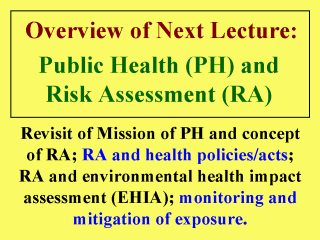 |
In the second lecture, the mission of public health and the concept of health risk assessment will be revisited and discussed more extensively, with the intent of providing a better appreciation of the interrelationship between epidemiology and toxicology. Health risk assessment is apparently not the sole component or function of public health. As a matter of fact, in several African countries where today more than 15% of the adults (ages 15 - 46) have some signs of HIV/AIDS (Science, 2000), it is almost inconceivable to think that RA is their formal public health function or priority.
Also to be included in the next lecture is a more extensive discussion of the impact of health policies or health regulations on RA. In the United States, for example, the Delaney clause of the FD&C Act states that food additives that cause cancer in humans or (laboratory) animals
at any level shall be prohibited from such use. As expected, since its inception, this amendment has changed much the course of risk assessment, as well as those of many epidemiologic and toxicologic investigations.
Another topic to be discussed is to relate RA to EHIA, the latter process dealing primarily with the impact of development projects on environmental health in the industrial and developing countries. The ultimate goal of both RA and EHIA is to protect community health by monitoring and mitigating the exposure to potentially harmful environmental contaminants, toxic biological or chemical substances, nuisance physical agents, and the like.

|
Go to Comment Form
|
|